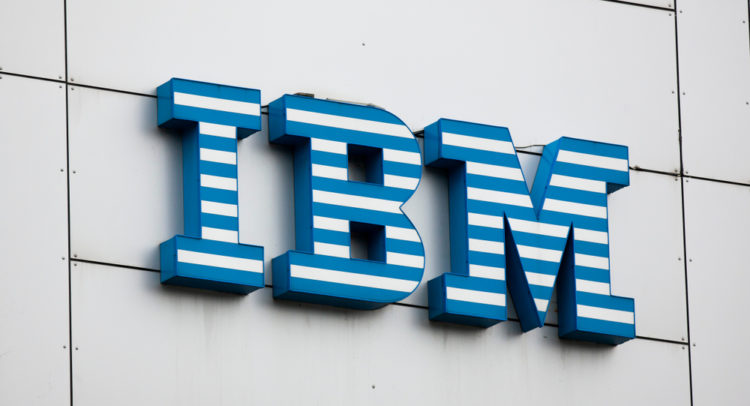International Business Machines Corporation (IBM) equips businesses all over the globe with integrated solutions and services.
The company is currently capitalizing on the hybrid cloud and AI opportunity with a platform-centric strategy that is concentrated on delivering two main sources of client value – technology and business expertise.
Specifically, the company supplies integrated solutions and products that securely leverage data and deep expertise in industries and business processes.
For instance, IBM’s hybrid cloud platform and AI technology aid clients’ digital transformation needs while assisting them with engaging their customers and employees in fresh ways.
With IBM struggling between transforming its own legacy businesses and improving its over-indebted balance sheet, the stock has struggled to deliver meaningful shareholder returns over the past decade. That said, positive advancements have been taking place.
For a start, Red Hat, one of IBM’s most recent and largest acquisitions, has been a key driver for the company that has rather revived its growth. In fact, Red Hat grew revenues by 30.6% last year. Additionally, the company has continued to deleverage, reducing its long-term debt from $58.4 billion in Q2 of 2019 to $44.9 billion, as of its latest report.
In my opinion, IBM could be a decent value play with its 5% dividend yield potentially serving income-oriented investors rather adequately.
That said, the tech sector likely holds better opportunities, especially after the latest correction. Further, IBM shares have little to offer apart from the dividend. Thus, I am neutral on IBM stock.
Latest Developments
IBM’s Q4 2021 results came in rather sound, with company-wide revenues rising 6.5% year-over-year to $16.7 billion. Diluted adjusted earnings per share also grew by 70.1% to $2.57 during this period.
Specifically, the company’s Software segment, which includes Hybrid Platform & Solutions and Transaction Processing, saw its revenues grow 10.1% to $7.3 billion. Growth was driven by Red Hat and automation services, which grew revenues by 21% and 15%, respectively.
IBM’s Consulting division also performed well, with its top line growing 15.7% to $4.7 billion. The increase was mainly driven by higher Business Transformation consulting fees, which increased by 20% compared to last year.
The spike in IBM’s EPS was due to the lack of extraordinary expenses that had occurred last year. That said, gross margins did slightly decline in Fiscal 2021, dropping from 55.9% to 54.9% year-over-year.
The company continued to allocate its operating cash flows towards deleveraging and returning cash to shareholders.
Deleveraging, Dividends, Buybacks
IBM shareholders currently face three value-creation catalysts: deleveraging, dividend growth, and share repurchases.
The company generated $12.8 billion in operating cash flows during Fiscal 2021. Of those, $5.97 billion were allocated towards reducing long-term debt, as mentioned earlier in the article.
Still, despite IBM ending the year with $7.6 billion in cash, the company remains heavily indebted. It is now featuring a net debt position of $47.9 billion.
In fiscal 2021 IBM continued to commit to its dividend per share growth. The latest DPS hike last summer was by a meager, but welcoming, 0.6% to a quarterly rate of $1.64. IBM now counts 26 years of consecutive annual dividend hikes, which positions the company within the S&P500’s Dividend Aristocrats Index.

However, note that IBM’s dividend growth prospects remain rather soft. The five-year DPS CAGR stands at 3.8%, with the company likely to continue strengthening the balance sheet before potentially re-accelerating dividend growth.
Hence, it’s more than likely that IBM’s dividend growth could underperform inflation in the next few years, which income-oriented investors should note.
Finally, IBM allocated around $319 million in stock repurchases. While stock repurchases have eased over the past few years relative to IBM’s heavy buyback volumes between 2005 and 2014, a declining share count should help boost the company’s per-share metrics. For context, since 1995, IBM has reduced its share count by nearly two-thirds.
Wall Street’s Take
Turning to Wall Street, International Business Machines Corporation has a Hold consensus rating based on four Buys, six Holds, and two Sells assigned in the past three months. At $144.08, IBM’s stock forecast suggests 11.3% upside potential.

Valuation & Conclusion
Analysts expect IBM to post EPS close to $10 for Fiscal 2022, implying a forward P/E of 12.9. While this may sound like an attractive multiple, revenue growth is unlikely to exceed the single digits over the medium term. Combined with the fact that IBM is heavily indebted, I would argue that the possibility for a meaningful valuation expansion is quite slim.
In my view, investors should continue pricing the stock based on its dividend yield, as IBM’s payouts are likely to constitute the majority of investor returns moving forward.
IBM’s dividend yield has hovered between 4% and 6.5% over the past three years. With dividend growth likely to remain underwhelming, there is a high possibility that IBM’s stock could trade sideways for a long time.
Consequently, unless one really appreciates IBM’s rather robust dividend track record, the stock’s investment case is unlikely to produce extraordinary total returns ahead.
Even then, IBM’s dividend growth is quite unlikely to match inflation levels even if we were to assume that the latter was to normalize in the coming years.
Download the TipRanks mobile app now
To find good ideas for stocks trading at attractive valuations, visit TipRanks’ Best Stocks to Buy, a newly launched tool that unites all of TipRanks’ equity insights.
Read full Disclaimer & Disclosure









